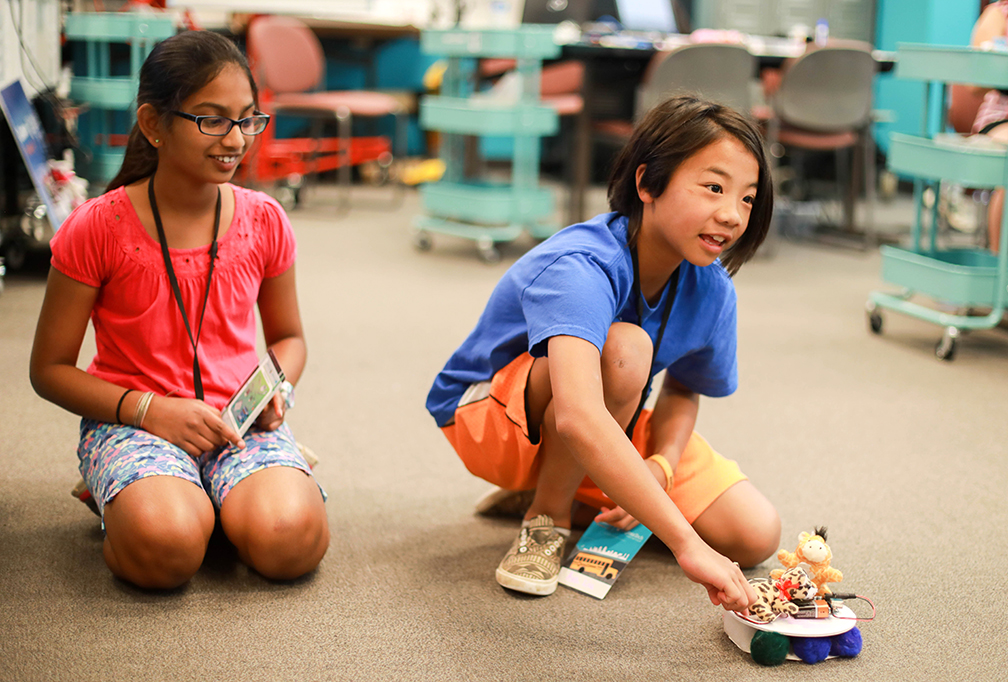Thinkabit Lab Inspires Thousands to Invent
September 26, 2017

Crafts and tools line the walls inside brightly painted rooms at the end of the first floor hall in Virginia Tech’s Falls Church campus in the National Capital Region.
It’s here in the Qualcomm Thinkabit Lab at Virginia Tech that, since 2016, more than 4,000 students and teachers, primarily from underserved and underrepresented communities in the D.C. area, have wired, programmed, and crafted their own unique inventions. Such creations include a roving robot vacuum topped with stuffed animals, a “dabbing” lion, model traffic light systems, and all kinds of environmental sensors. In the process, students are exposed to careers and opportunities in the areas of science, technology, engineering, and mathematics, mostly for the first time.
The Thinkabit Lab is led by Virginia Tech’s Department of Engineering Education in the College of Engineering and School of Education in the College of Liberal Arts and Human Sciences, based on Qualcomm’s World of Work and STEM coursework.
“Most of the young people that visit our lab will still be working full-time until 2065 or beyond. We want to start building their communication skills, technical skills, and technical career awareness today,” said Jim Egenrieder, director of the lab and a member of Virginia Tech’s research faculty.
The program’s impact should expand in the coming months with the creation of several new Inspired by Qualcomm Thinkabit Lab sites in schools and libraries throughout Virginia.
Sites are being opened in Radford City Schools, Prince William County Schools, Fairfax County Schools, and Harrisonburg City Schools.
Celebrating its one-year anniversary this month, the center offers both teachers and students an engaging learning environment — part lab, makerspace, and classroom — to foster creativity, collaboration, and the critical skills necessary for an increasingly global, technology-driven workforce.
“We are thrilled to witness the success that the Thinkabit Lab has had in the D.C. area, showing students from all walks of life that they can invent the future and that STEM careers might be for them,” said Susie Armstrong, senior vice president of engineering at Qualcomm Inc. “We look forward to continue collaborating with Virginia Tech in the next several years.”
On any given day in the Thinkabit Lab, students of all ages are provided electronic microcontrollers, hand tools, shelves full of cardboard, crafts, plastic figurines, stuffed animals, and decorations. They’re tasked with creating a moving “robo-craft,” in the process learning about programming, engineering, and invention within the context of STEM careers.
As the first Thinkabit Lab outside of San Diego, California, the Falls Church-based experience focuses on exploring the Internet of Things, smart cities, creative robotics and electronics, and environmental sensors and monitoring.
“The Thinkabit Lab is designed to supplement the great things that are going on in schools in the National Capital Region,” said Egenrieder. “It’s not easy to get access to some of this equipment, and we want to support teachers who are interested in using these tools and technologies in their curricula.”
The original Thinkabit Lab has served more than 12,000 students and educators since launching at Qualcomm’s San Diego headquarters in 2014 and has been replicated in multiple middle schools and a library in San Diego.
At last count, the Virginia Tech Thinkabit Lab has seen:
- 4,300 student visits;
- 920 visits by teachers and administrators;
- 215 visits by school and community collaborators;
- engagement from 770 business and community leaders;
- 445 parent visits;
- 140 “robo-crafting” classes; and
- the creation of more than 2,000 robo-crafts.
Egenrieder said these numbers reflect an expansion of the original Thinkabit Lab model developed in San Diego, since the Virginia Tech site invited both younger and older students to the campus.
On top of the outreach done for school groups, teachers, school administrators, and others, Egenrieder recruits pre-college students for internships. Some interns are funded by the U.S. Department of Education, and some are placed through a collaboration with Urban Alliance and On-Ramps to Careers, both organizations that help underresourced youth find internships during high school.
Interns in the Thinkabit Lab work with younger students on their inventions and help keep the activities running smoothly. Egenrieder said interns are empowered and trusted to take on responsibilities, such as researching new ideas and equipment and providing recommendations with minimal management. Interns are also allocated time to take on their own personal research projects in any area they choose.
“I’ve had internships throughout my career, including when I was a Virginia Tech graduate student, that — without being hyperbolic — changed my life,” said Egenrieder, who earned both his master’s degree and doctorate from the School of Education. “I had these new exposures, a new sense of self, that led to these meaningful transformative experiences that rerouted me or gave me a new confidence or expectation of what I was capable of doing and, in most cases, sooner than I would have otherwise.”
Incoming Virginia Tech engineering freshman Emma Peiffer intends to take advantage of the opportunity to explore a research project in aerospace engineering. Since she was younger, Peiffer loved math and science, but first was drawn to aerospace engineering specifically after meeting a teacher who had once worked at NASA.
Now, Peiffer — who also participated in the Virginia Tech College of Engineering’s C-Tech² pre-college program — can spend part of her internship diving a little deeper into the field.
“I can start building up a background so I can go to future employers and be like, ‘look, I made all these things,’” Peiffer said.
The momentum of the Thinkabit Lab’s many programs isn’t slowing in the coming months. Egenrieder said his team has plans to develop educational programs for returning military service members and for Arlington County-based “lifelong learners,” students over 50 years of age exploring the Internet of Things and microelectronics.
Written by Erica Corder













